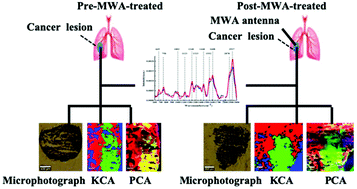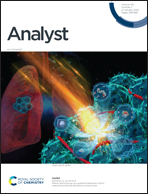Study on the biochemical mechanisms of the micro-wave ablation treatment of lung cancer by ex vivo confocal Raman microspectral imaging†
Abstract
As a highly invasive and the most prevalent malignancy, lung cancer remains the leading cause of cancer-associated mortality worldwide, especially in China. Microwave ablation (MWA) is an effective, safe, and the least invasive ablative treatment modality, which has been increasingly used for the management of unrespectable lung tumors. However, the underlying biochemical mechanisms of MWA treatment remain to be incompletely elucidated. Therefore, to illustrate the complex biochemical responses of lung squamous cell carcinoma (LSCC) to MWA treatment, confocal Raman micro-spectral imaging (CRMI) was applied in combination with multivariate analysis. A total of twelve LSCC tissues were acquired from patients undergoing clinical treatment, and their spectral characteristics were analyzed to determine significant spectral variations following cancer progression and MWA treatment in comparison with healthy lung tissues. Point-scanned Raman datasets were acquired from sectioned tissue samples in both pre-therapy (Pre-MWA group) and post-therapy groups (Post-MWA group) and further analyzed using K-means cluster analysis (KCA) and principal component analysis (PCA) to highlight the detailed compositional variations of the biochemical constituents. The spectral variations of essential amino acids (such as phenylalanine and tryptophan), collagen, and nucleic acids in the cancerous tissues of the Post-MWA group were significantly enhanced compared to those in the Pre-MWA group. The acquired information further confirmed a remarkable increase in the content of nucleic acid, protein, and lipid in the cancerous tissue following MWA treatment and, a comparative spectral imaging investigation indicated that MWA had no noticeable adverse effects on the paracancerous tissues. Thus, the findings not only illustrated the underlying biochemical variability in lung cancer during MWA treatment but also further confirmed the feasibility of a combined analytical procedure for assessing the biochemical responses during thermal ablation, which could be applied to prominently enhance the effectiveness of MWA in lung cancer treatment in clinical settings.



 Please wait while we load your content...
Please wait while we load your content...